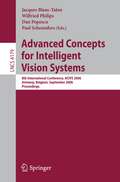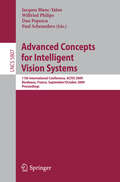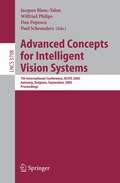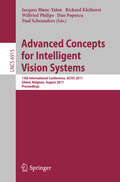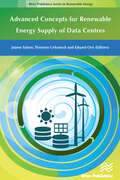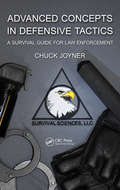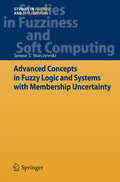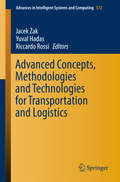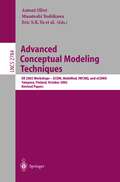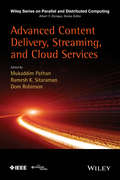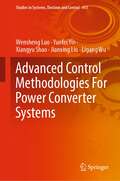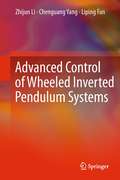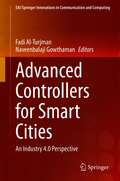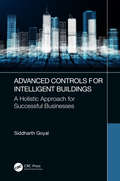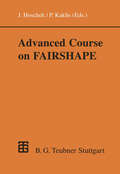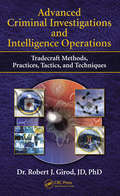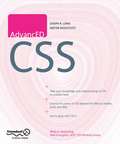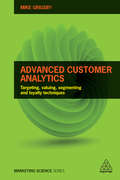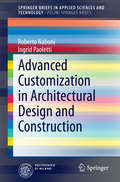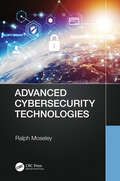- Table View
- List View
Advanced Concepts for Intelligent Vision Systems: 8th International Conference, ACIVS 2006, Antwerp, Belgium, September 18-21, 2006, Proceedings (Lecture Notes in Computer Science #4179)
by Wilfried Philips Dan Popescu Paul ScheundersThis book constitutes the refereed proceedings of the 8th International Conference on Advanced Concepts for Intelligent Vision Systems, ACIVS 2006. The book presents 45 revised full papers and 65 revised poster papers. Topical sections include noise reduction and restoration, segmentation, motion estimation and tracking, video processing and coding, camera calibration, image registration and stereo matching, biometrics and security, medical imaging, image retrieval and image understanding, and more.
Advanced Concepts for Intelligent Vision Systems: 11th International Conference, ACIVS 2009 Bordeaux, France, September 28--October 2, 2009 Proceedings (Lecture Notes in Computer Science #5807)
by Wilfried Philips Dan Popescu Paul ScheundersThis book constitutes the refereed proceedings of the 11th International Conference on Advanced Concepts for Intelligent Vision Systems, ACIVS 2009, held in Bordeaux, France in September/October 2009. The 43 revised full papers and 25 posters presented were carefully reviewed and selected from 115 submissions. The papers are organized in topical sections on technovision, fundamental mathematical techniques, image processing, coding and filtering, image and video analysis, computer vision, tracking, color, multispectral and special-purpose imaging, medical imaging, and biometrics.
Advanced Concepts for Intelligent Vision Systems: 7th International Conference, ACIVS 2005, Antwerp, Belgium, September 20-23, 2005, Proceedings (Lecture Notes in Computer Science #3708)
by Wilfried Philips Dan Popescu Paul ScheundersAdvanced Concepts for Intelligent Vision Systems: 13th International Conference, ACIVS 2011, Ghent, Belgium, August 22-25, 2011, Proceedings (Lecture Notes in Computer Science #6915)
by Paul Scheunders Richard Kleihorst Jaques Blanc-Talon Wilfried Philips Dan PopescuThis book constitutes the refereed proceedings of the 13th International Conference on Advanced Concepts for Intelligent Vision Systems, ACIVS 2011, held in Ghent, Belgium, in August 2011. The 66 revised full papers presented were carefully reviewed and selected from 124 submissions. The papers are organized in topical sections on classification recognition, and tracking, segmentation, images analysis, image processing, video surveillance and biometrics, algorithms and optimization; and 3D, depth and scene understanding.
Advanced Concepts for Renewable Energy Supply of Data Centres (River Publishers Series In Renewable Energy Ser.)
by Jaume Salom Thorsten Urbaneck Eduard OróThe rapid increase of cloud computing, high performance computing (HPC) and the vast growth in Internet and Social Media use have aroused the interest in energy consumption and the carbon footprint of Data Centres. Data Centres primarily contain electronic equipment used for data processing (servers), data storage (storage equipment), and communications (network equipment). Collectively, this equipment processes, stores, and transmits digital information and is known as information technology (IT) equipment. Advanced Concepts for Renewable Energy Supply of Data Centres introduces a number of technical solutions for the supply of power and cooling energy into Data Centres with enhanced utilisation of renewable energy sources in order to achieve low energy Data Centres. Because of the high energy density nature of these unique infrastructures, it is essential to implement energy efficiency measures and reduce consumption before introducing any renewable energy source. A holistic approach is used with the objective of integrating many technical solutions such as management of the IT (Information Technology) load, efficient electrical supply to the IT systems, Low-Ex air-conditioning systems, interaction with district heating and cooling networks, re-use of heat, free cooling (air, seawater, groundwater), optimal use of heat and cold storage, electrical storage and integration in smart grids. This book is therefore a catalogue of advanced technical concepts that could be integrated into Data Centres portfolio in order to increase the overall efficiency and the share of renewable energies in power and cooling supply. Based on dynamic energy models implemented in TRNSYS some concepts are deeply evaluated through yearly simulations. The results of the simulation are illustrated with Sankey charts, where the energy flows per year within the subsystems of each concept for a selected scenario are shown, and graphs showing the results of parametric analysis. A set of environmental metrics (as the non-renewable primary energy) and financial metrics (CAPEX and OPEX) as well of energy efficiency metrics like the well-known PUE, are described and used to evaluate the different technical concepts.
Advanced Concepts for Renewable Energy Supply of Data Centres
The rapid increase of cloud computing, high performance computing (HPC) and the vast growth in Internet and Social Media use have aroused the interest in energy consumption and the carbon footprint of Data Centres. Data Centres primarily contain electronic equipment used for data processing (servers), data storage (storage equipment), and communications (network equipment). Collectively, this equipment processes, stores, and transmits digital information and is known as information technology (IT) equipment. Advanced Concepts for Renewable Energy Supply of Data Centres introduces a number of technical solutions for the supply of power and cooling energy into Data Centres with enhanced utilisation of renewable energy sources in order to achieve low energy Data Centres. Because of the high energy density nature of these unique infrastructures, it is essential to implement energy efficiency measures and reduce consumption before introducing any renewable energy source. A holistic approach is used with the objective of integrating many technical solutions such as management of the IT (Information Technology) load, efficient electrical supply to the IT systems, Low-Ex air-conditioning systems, interaction with district heating and cooling networks, re-use of heat, free cooling (air, seawater, groundwater), optimal use of heat and cold storage, electrical storage and integration in smart grids. This book is therefore a catalogue of advanced technical concepts that could be integrated into Data Centres portfolio in order to increase the overall efficiency and the share of renewable energies in power and cooling supply. Based on dynamic energy models implemented in TRNSYS some concepts are deeply evaluated through yearly simulations. The results of the simulation are illustrated with Sankey charts, where the energy flows per year within the subsystems of each concept for a selected scenario are shown, and graphs showing the results of parametric analysis. A set of environmental metrics (as the non-renewable primary energy) and financial metrics (CAPEX and OPEX) as well of energy efficiency metrics like the well-known PUE, are described and used to evaluate the different technical concepts.
Advanced Concepts in Defensive Tactics: A Survival Guide for Law Enforcement
by Chuck JoynerToday‘s society is becoming increasingly more likely to resist the lawful actions of law enforcement officers. It is critical for officers to have the necessary defensive tactics (DT) skills to successfully overcome resistance in an efficient, safe, and legal manner. The answer to achieving these results is NOT in teaching thousands of possible res
Advanced Concepts in Fuzzy Logic and Systems with Membership Uncertainty (Studies in Fuzziness and Soft Computing #284)
by Janusz T. StarczewskiThis book generalizes fuzzy logic systems for different types of uncertainty, including- semantic ambiguity resulting from limited perception or lack of knowledge about exact membership functions- lack of attributes or granularity arising from discretization of real data- imprecise description of membership functions- vagueness perceived as fuzzification of conditional attributes.Consequently, the membership uncertainty can be modeled by combining methods of conventional and type-2 fuzzy logic, rough set theory and possibility theory. In particular, this book provides a number of formulae for implementing the operation extended on fuzzy-valued fuzzy sets and presents some basic structures of generalized uncertain fuzzy logic systems, as well as introduces several of methods to generate fuzzy membership uncertainty. It is desirable as a reference book for under-graduates in higher education, master and doctor graduates in the courses of computer science, computational intelligence, or fuzzy control and classification, and is especially dedicated to researchers and practitioners in industry.
Advanced Concepts, Methodologies and Technologies for Transportation and Logistics (Advances in Intelligent Systems and Computing #572)
by Jacek Żak Yuval Hadas Riccardo RossiThis book is a collection of original papers produced by the members of the Euro Working Group on Transportation (EWGT) in the last several years (2015–2017). The respective chapters present the results of various research projects carried out by the members of the EWGT and extended versions of presentations given at the last several meetings of the EWGT. The book offers a representative sampling of the EWGT’s research activities and covers the state-of-the-art in quantitative oriented transportation/logistics research. It highlights a range of advanced concepts, methodologies and technologies, divided into four major thematic streams: Multiple Criteria Analysis in Transportation and Logistics; Urban Transportation and City Logistics; Road Safety and Artificial Intelligence and Soft Computing in Transportation and Logistics. The book is intended for academics/researchers, analysts, business consultants, and graduate students who are interested in advanced techniques of mathematical modeling and computational procedures applied in transportation and logistics.
Advanced Conceptual Modeling Techniques: ER 2002 Workshops - ECDM, MobIMod, IWCMQ, and eCOMO, Tampere, Finland, October 7-11, 2002, Proceedings (Lecture Notes in Computer Science #2784)
by Antoni Olivé Masatoshi Yoshikawa Eric S. K. YuThe objective of the workshops held in conjunction with ER 2002, the 21st International Conference on Conceptual Modeling, was to give participants the opportunitytopresentanddiscussemerginghottopics,thusaddingnewpersp- tives to conceptual modeling. To meet this objective, we selected the following four workshops: – 2nd InternationalWorkshop on Evolution and Changein Data Management (ECDM 2002) – ER/IFIP8. 1 Workshop on Conceptual Modelling Approaches to Mobile - formation Systems Development (MobIMod 2002) – International Workshop on Conceptual Modeling Quality (IWCMQ 2002) – 3rd International Joint Workshop on Conceptual Modeling Approaches for E-business: a Web Service Perspective (eCOMO 2002) ER 2002 was organized so that there would be no overlap between the c- ference sessions and the workshops. This proceedings contains workshop papers that wererevisedby the authors following discussions during the conference. We are deeply indebted to the members of the organizing committees and program committees of these workshops for their hard work. July 2003 Antoni Oliv´ e, Masatoshi Yoshikawa, and Eric S. K. Yu Workshop Co-chairs ER 2002 ECDM 2002 Change is a fundamental but sometimes neglected aspect of information and database systems. The management of evolution and change and the ability of database, information and knowledge-based systems to deal with change is an essential component in developing and maintaining truly useful systems. Many approachestohandlingevolutionandchangehavebeenproposedinvariousareas of data management, and this forum seeks to bring together researchers and practitioners from both more established areas and from emerging areas to look at this issue.
Advanced Content Delivery, Streaming, and Cloud Services (Wiley Series on Parallel and Distributed Computing)
by Mukaddim Pathan Ramesh K. Sitaraman Dom RobinsonWhile other books on the market provide limited coverage of advanced CDNs and streaming technologies, concentrating solely on the fundamentals, this book provides an up-to-date comprehensive coverage of the state-of-the-art advancements in CDNs, with a special focus on Cloud-based CDNs. The book includes CDN and media streaming basics, performance models, practical applications, and business analysis. It features industry case studies, CDN applications, and open research issues to aid practitioners and researchers, and a market analysis to provide a reference point for commercial entities. The book covers Adaptive Bitrate Streaming (ABR), Content Delivery Cloud (CDC), Web Acceleration, Front End Optimization (FEO), Transparent Caching, Next Generation CDNs, CDN Business Intelligence and more. Provides an in-depth look at Cloud-based CDNs Includes CDN and streaming media basics and tutorials Aimed to instruct systems architects, practitioners, product developers, and researchers Material is divided into introductory subjects, advanced content, and specialist areas
Advanced Content Delivery, Streaming, and Cloud Services (Wiley Series on Parallel and Distributed Computing)
by Mukaddim Pathan Ramesh K. Sitaraman Dom RobinsonWhile other books on the market provide limited coverage of advanced CDNs and streaming technologies, concentrating solely on the fundamentals, this book provides an up-to-date comprehensive coverage of the state-of-the-art advancements in CDNs, with a special focus on Cloud-based CDNs. The book includes CDN and media streaming basics, performance models, practical applications, and business analysis. It features industry case studies, CDN applications, and open research issues to aid practitioners and researchers, and a market analysis to provide a reference point for commercial entities. The book covers Adaptive Bitrate Streaming (ABR), Content Delivery Cloud (CDC), Web Acceleration, Front End Optimization (FEO), Transparent Caching, Next Generation CDNs, CDN Business Intelligence and more. Provides an in-depth look at Cloud-based CDNs Includes CDN and streaming media basics and tutorials Aimed to instruct systems architects, practitioners, product developers, and researchers Material is divided into introductory subjects, advanced content, and specialist areas
Advanced Control Methodologies For Power Converter Systems (Studies in Systems, Decision and Control #413)
by Ligang Wu Jianxing Liu Yunfei Yin Wensheng Luo Xiangyu ShaoThis book aims to present some advanced control methodologies for power converters. Power electronic converters have become indispensable devices for plenty of industrial applications over the last decades. Composed by controllable power switches, they can be controlled by effective strategies to achieve desirable transient response and steady-state performance, to ensure the stability, reliability and safety of the system. The most popular control strategy of power converters is the linear proportional–integral–derivative series control which is adopted as industry standard. However, when there exist parameter changes, nonlinearities and load disturbances in the system, the performance of the controller will be significantly degraded. To overcome this problem, many advanced control methodologies and techniques have been developed to improve the converter performance. This book presents the research work on some advanced control methodologies for several types of power converters, including three-phase two-level AC/DC power converter, three-phase NPC AC/DC power converter, and DC/DC buck converter. The effectiveness and advantage of the proposed control strategies are verified via simulations and experiments. The content of this book can be divided into two parts. The first part focuses on disturbance observer-based control methods for power converters under investigation. The second part investigates intelligent control methods. These methodologies provide a framework for controller design, observer design, stability and performance analysis for the considered power converter systems.
Advanced Control of Wheeled Inverted Pendulum Systems
by Zhijun Li Chenguang Yang Liping FanAdvanced Control of Wheeled Inverted Pendulum Systems is an orderly presentation of recent ideas for overcoming the complications inherent in the control of wheeled inverted pendulum (WIP) systems, in the presence of uncertain dynamics, nonholonomic kinematic constraints as well as underactuated configurations. The text leads the reader in a theoretical exploration of problems in kinematics, dynamics modeling, advanced control design techniques and trajectory generation for WIPs. An important concern is how to deal with various uncertainties associated with the nominal model, WIPs being characterized by unstable balance and unmodelled dynamics and being subject to time-varying external disturbances for which accurate models are hard to come by. The book is self-contained, supplying the reader with everything from mathematical preliminaries and the basic Lagrange-Euler-based derivation of dynamics equations to various advanced motion control and force control approaches as well as trajectory generation method. Although primarily intended for researchers in robotic control, Advanced Control of Wheeled Inverted Pendulum Systems will also be useful reading for graduate students studying nonlinear systems more generally.
Advanced Controllers for Smart Cities: An Industry 4.0 Perspective (EAI/Springer Innovations in Communication and Computing)
by Fadi Al-Turjman Naveenbalaji GowthamanThis book provides basic knowledge of advanced microcontrollers associated with large systems and devices. The book determines the feasibility of the advanced controllers from an Industry 4.0 perspective, which is associated with Integrated Internet of Things (IIoT) when developing larger smart cities. Also, it describes potential applications, key areas of Industry 4.0, and controlling applications with microcontrollers. Chapters include IoT with integrated control applications in smart city paradigm; agriculture, public safety, women and child care & welfare; healthcare, water management, government and administration; environmental impact, energy with management of information systems; and safety, education, transportation systems with advanced controllers.
Advanced Controls for Intelligent Buildings: A Holistic Approach for Successful Businesses
by Siddharth GoyalThis book focuses primarily on both technical and business aspects needed to select, design, develop and deploy control application (or product) successfully for multiple components in building systems. Designing and deploying a control application require multiple steps such as sensing, system dynamics modelling, algorithms, and testing. This may involve choosing an appropriate methodology and technique at multiple stages during the development process. Understanding the pros and cons of such techniques, most importantly being aware of practically possible approaches in the entire ecosystem, is critical in choosing the best framework and system application for different parts of building systems. Providing a wide overview of the state-of art in controls and building systems, providing guidance on developing an end-to-end system in relation to business fundamentals (distribution channels, stakeholders, marketing, supply-chain and financial management), the book is ideal for fourth-year control/mechanical/electrical engineering undergraduates, graduate students, and practitioners including business leaders concerned with smart building technology.
Advanced Controls for Intelligent Buildings: A Holistic Approach for Successful Businesses
by Siddharth GoyalThis book focuses primarily on both technical and business aspects needed to select, design, develop and deploy control application (or product) successfully for multiple components in building systems. Designing and deploying a control application require multiple steps such as sensing, system dynamics modelling, algorithms, and testing. This may involve choosing an appropriate methodology and technique at multiple stages during the development process. Understanding the pros and cons of such techniques, most importantly being aware of practically possible approaches in the entire ecosystem, is critical in choosing the best framework and system application for different parts of building systems. Providing a wide overview of the state-of art in controls and building systems, providing guidance on developing an end-to-end system in relation to business fundamentals (distribution channels, stakeholders, marketing, supply-chain and financial management), the book is ideal for fourth-year control/mechanical/electrical engineering undergraduates, graduate students, and practitioners including business leaders concerned with smart building technology.
Advanced Criminal Investigations and Intelligence Operations: Tradecraft Methods, Practices, Tactics, and Techniques
by Robert J GirodTradecraft is a term used within the intelligence community to describe the methods, practices, and techniques used in espionage and clandestine investigations. Whether the practitioner is a covert agent for the government or an identity thief and con man, the methods, practices, tactics, and techniques are often the same and sometimes learned from
AdvancED CSS
by Joe Lewis Meitar MoscovitzSo you think you know CSS? Take your CSS skills to the next level and learn to write organized and optimized CSS that will improve the maintainability, performance, and appearance of your work. You'll learn how document flow and CSS positioning schemes will help you make your documents more accessible. You'll discover the great styling possibilities of CSS paired with semantic structures like Microformats and RDFa, while enriching the self-describing semantics of XHTML content. Learn how to group logically related declarations, minify style sheets, and prevent performance bottle necks such as reflows and repaints. With support for CSS enjoying unprecedented ubiquity, you can finally use such features as generated content, complex selector chains, and CSS3's visual properties, like box-shadow, in your projects.
Advanced Customer Analytics: Targeting, Valuing, Segmenting and Loyalty Techniques (Marketing Science)
by Mike GrigsbyAdvanced Customer Analytics provides a clear guide to the specific analytical challenges faced by the retail sector. The book covers the nature and scale of data obtained in transactions, relative proximity to the consumer and the need to monitor customer behaviour across multiple channels. The book advocates a category management approach, taking into account the need to understand the consumer mindset through elasticity modelling and discount strategies, as well as targeted marketing and loyalty design.A practical, no-nonsense approach to complex scenarios is taken throughout, breaking down tasks into easily digestible steps. The use of a fictional retail analyst 'Scott' helps to provide accessible examples of practice. Advanced Customer Analytics does not skirt around the complexities of this subject but offers conceptual support to steer retail marketers towards making the right choices for analysing their data. Online resources include a selection of datasets to support specific chapters.
Advanced Customer Analytics: Targeting, Valuing, Segmenting and Loyalty Techniques (Marketing Science)
by Mike GrigsbyAdvanced Customer Analytics provides a clear guide to the specific analytical challenges faced by the retail sector. The book covers the nature and scale of data obtained in transactions, relative proximity to the consumer and the need to monitor customer behaviour across multiple channels. The book advocates a category management approach, taking into account the need to understand the consumer mindset through elasticity modelling and discount strategies, as well as targeted marketing and loyalty design.A practical, no-nonsense approach to complex scenarios is taken throughout, breaking down tasks into easily digestible steps. The use of a fictional retail analyst 'Scott' helps to provide accessible examples of practice. Advanced Customer Analytics does not skirt around the complexities of this subject but offers conceptual support to steer retail marketers towards making the right choices for analysing their data. Online resources include a selection of datasets to support specific chapters.
Advanced Customization in Architectural Design and Construction (SpringerBriefs in Applied Sciences and Technology)
by Roberto Naboni Ingrid PaolettiThis book presents the state of the art in advanced customization within the sector of architectural design and construction, explaining important new technologies that are boosting design, product and process innovation and identifying the challenges to be confronted as we move toward a mass customization construction industry. Advanced machinery and software integration are discussed, as well as an overview of the manufacturing techniques offered through digital methods that are acquiring particular significance within the field of digital architecture. CNC machining, Robotic Fabrication, and Additive Manufacturing processes are all clearly explained, highlighting their ability to produce personalized architectural forms and unique construction components. Cutting-edge case studies in digitally fabricated architectural realizations are described and, looking towards the future, a new model of 100% customized architecture for design and construction is presented. The book is an excellent guide to the profound revolution taking place within the fields of architectural design and construction, characterized by computational tools, advanced fabrication means and custom-made high-performance architecture.
Advanced Cybersecurity Technologies
by Ralph MoseleyCybersecurity is an extremely important area which is rapidly evolving, necessarily, to meet current and future threats. Anyone who studies within this domain requires a particular skillset and way of thinking, balancing technical knowledge and human insight. It is vital to recognize both sides of this complex area and integrate the two. This book looks at the technical fields progressively, building up in layers before expanding into more advanced topics. Each area is looked at succinctly, describing the main elements and problems in each area and reinforcing these concepts with practical coding examples, questions and ideas for further research. The book builds on an overview of basic architecture of systems and networks, setting a context for how information is vulnerable. Cryptography is explained in detail with examples, showing the steady progress in this area over time through to the possibilities of quantum encryption. Steganography is also explained, showing how this can be used in a modern-day context through multimedia and even Virtual Reality. A large section of the book is given to the technical side of hacking, how such attacks occur, how they can be avoided and what to do after there has been an intrusion of some description. Cyber countermeasures are explored, along with automated systems of defense, whether created by the programmer or through firewalls and suchlike. The human aspect of cyber security is detailed along with the psychology and motivations for launching attacks. Social engineering is focused on and with the various techniques looked at – revealing how an informed individual, organization or workplace can protect themselves against incursions and breaches. Finally, there is a look the latest developments in the field, and how systems, such as the IoT are being protected. The book is intended for advanced undergraduate and postgraduate courses on cybersecurity but is also useful for those studying IT or Computer Science more generally.
Advanced Cybersecurity Technologies
by Ralph MoseleyCybersecurity is an extremely important area which is rapidly evolving, necessarily, to meet current and future threats. Anyone who studies within this domain requires a particular skillset and way of thinking, balancing technical knowledge and human insight. It is vital to recognize both sides of this complex area and integrate the two. This book looks at the technical fields progressively, building up in layers before expanding into more advanced topics. Each area is looked at succinctly, describing the main elements and problems in each area and reinforcing these concepts with practical coding examples, questions and ideas for further research. The book builds on an overview of basic architecture of systems and networks, setting a context for how information is vulnerable. Cryptography is explained in detail with examples, showing the steady progress in this area over time through to the possibilities of quantum encryption. Steganography is also explained, showing how this can be used in a modern-day context through multimedia and even Virtual Reality. A large section of the book is given to the technical side of hacking, how such attacks occur, how they can be avoided and what to do after there has been an intrusion of some description. Cyber countermeasures are explored, along with automated systems of defense, whether created by the programmer or through firewalls and suchlike. The human aspect of cyber security is detailed along with the psychology and motivations for launching attacks. Social engineering is focused on and with the various techniques looked at – revealing how an informed individual, organization or workplace can protect themselves against incursions and breaches. Finally, there is a look the latest developments in the field, and how systems, such as the IoT are being protected. The book is intended for advanced undergraduate and postgraduate courses on cybersecurity but is also useful for those studying IT or Computer Science more generally.
